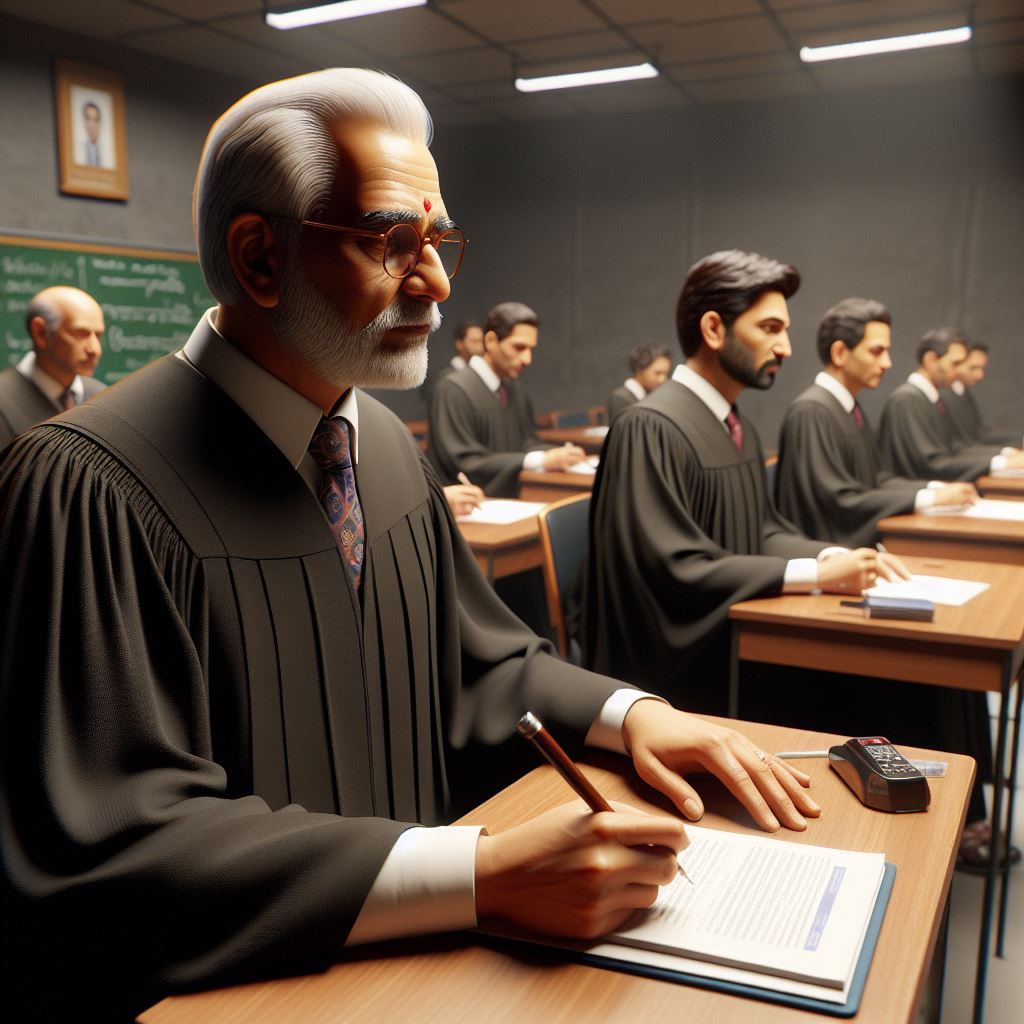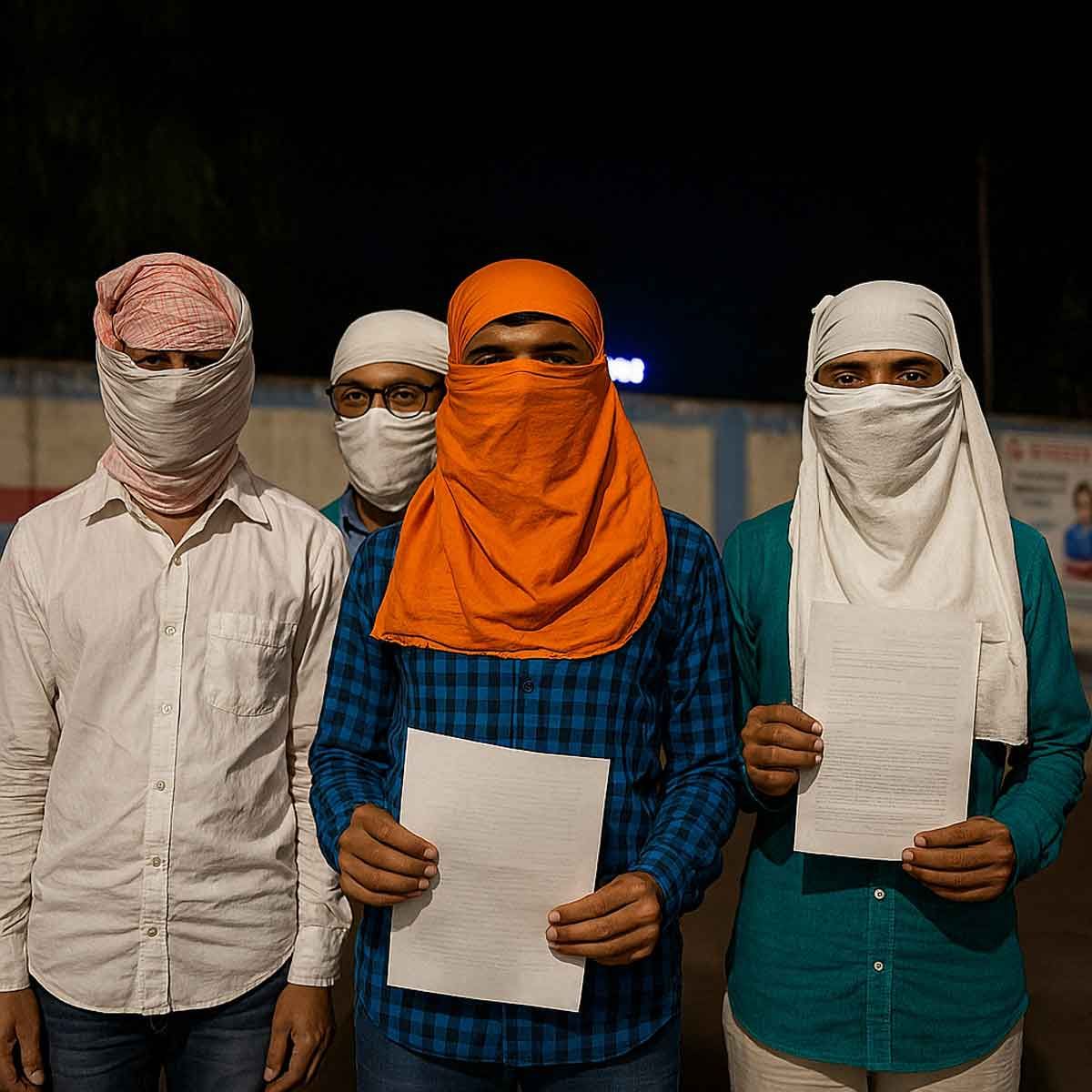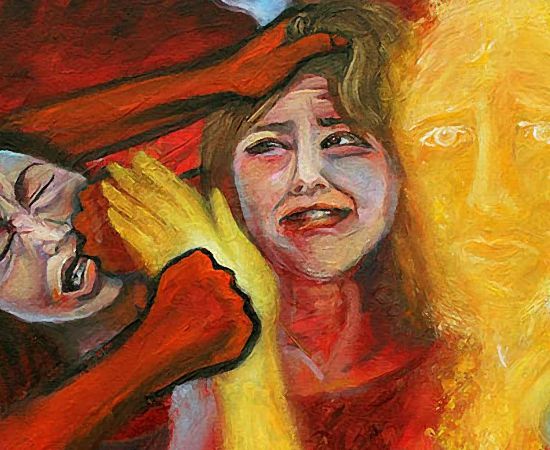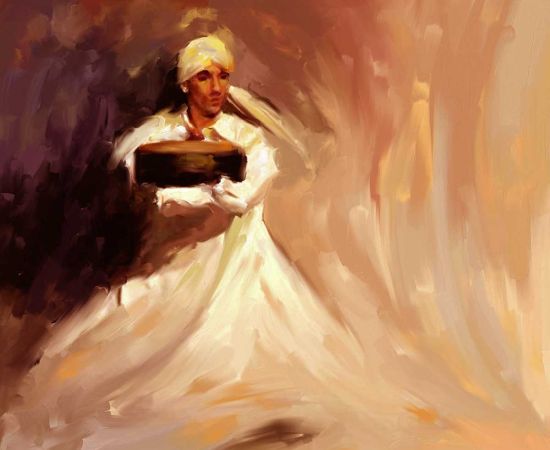More Coverage
Twitter Coverage
Satyaagrah
Written on
Satyaagrah
Written on
Satyaagrah
Written on
Satyaagrah
Written on
Satyaagrah
Written on
JOIN SATYAAGRAH SOCIAL MEDIA
"Order Order बाद में, पहले exam की तैयारी करो": President Murmu champions the All India Judicial Service, aiming to revolutionize judicial recruitment across states, akin to UPSC's nationwide approach – a transformative stride in India's legal landscape

During her inaugural address at the Supreme Court’s Constitution Day celebration on November 26, President Droupadi Murmu made a compelling call for the establishment of an "all-India judicial service" for the recruitment of judges. This proposal is aimed at enhancing diversity within the judiciary by increasing representation from marginalized social groups.
|
President Murmu emphasized, "There can be an all-India judicial service which can select brilliant youngsters and nurture and promote their talents from lower levels to higher levels." This statement underlines her vision for a judicial system that not only identifies but also fosters and advances the capabilities of young legal minds. By focusing on the growth and development of these individuals, the proposed service aims to build a strong foundation for the future judiciary.
Further elaborating on her idea, the President stated, "Those who aspire to serve the Bench can be selected from across the country to create a larger pool of talent." This approach to recruitment is intended to break geographical barriers, allowing for a more diverse and extensive selection of candidates nationwide. Such a wide-reaching method ensures that the best talents, irrespective of their location, get the opportunity to contribute to the judiciary.
President Murmu also highlighted the inclusive nature of the proposed service, saying, "Such a system can offer opportunities to the less-represented social groups too." This aspect of the proposal is crucial as it addresses the need for a more representative judicial system that mirrors the diverse composition of Indian society. By providing opportunities to those from less-represented groups, the service aims to make the judiciary more accessible and equitable.
What is the All India Judicial Service?
The All India Judicial Service (AIJS), as proposed and discussed, is rooted in the Indian Constitution. Specifically, Article 312 of the Constitution lays the groundwork for establishing the AIJS, aligning it with the central civil services. This article is crucial as it provides the constitutional framework and legal backing for the creation of such a service.
To initiate the establishment of the AIJS, a specific procedure must be followed as outlined in the Constitution. It starts in the Rajya Sabha, the upper house of India's Parliament. The Rajya Sabha must pass a resolution stating that it's necessary or expedient to create such a service in the "national interest." This resolution requires robust support—it must be backed by at least two-thirds of the members who are present and voting. The significance of this requirement is to ensure that there is a substantial consensus among the lawmakers on the need for this service.
Once the Rajya Sabha passes the resolution, the next step involves the Parliament's role. The Constitution states, "the Parliament 'may by law provide for the creation of one or more all India services (including an all India judicial service) common to the Union and the States'" and also take charge of regulating the recruitment and service conditions of persons appointed to any such service. This means that after the Rajya Sabha's resolution, it is up to the Parliament to enact legislation that will formally establish the AIJS. This legislation would detail how the service will function, how its members will be recruited, and the conditions of their service.
The All India Judicial Service (AIJS), as envisioned, has specific guidelines regarding the level of judicial posts it can encompass. Article 312 (2) of the Indian Constitution explicitly states that the AIJS "cannot include any post inferior to that of a district judge," as defined under Article 236. This limitation is crucial in understanding the scope and level of judiciary that the AIJS is intended to cover.
A district judge's role is diverse and includes several judicial positions. These positions can range from a city civil court judge to an additional district judge, a joint district judge, an assistant district judge, the chief judge of a small cause court, a chief presidency magistrate, an additional chief presidency magistrate, a sessions judge, an additional sessions judge, and an assistant sessions judge. This broad range captures the higher levels of the judiciary at the district level, ensuring that the AIJS targets a significant echelon within the judicial system.
The primary goal of the AIJS is to centralize the recruitment process for these higher judicial positions, similar to how district judges and additional district judges are appointed in all states. This centralized system is analogous to the recruitment process conducted by the Union Public Service Commission (UPSC), which manages a nationwide competitive examination to select candidates for various civil services. After successful candidates are chosen through the UPSC, they are assigned to different cadres across the country.
Likewise, the AIJS proposes a centralized mechanism for recruiting judges of the lower judiciary. Once selected, these judges would then be assigned to different states. This approach aims to streamline the recruitment process, ensuring uniformity and high standards in the selection of judges. By centralizing recruitment, the AIJS seeks to maintain consistency in the quality of judges appointed across different states, thereby enhancing the overall effectiveness and efficiency of the Indian judicial system. This system is expected to open avenues for talented legal professionals from diverse backgrounds to serve in various regions, promoting a more balanced representation in the judiciary.
How Will the AIJS Differ from the Current Selection System?
The current system of selecting judges in India, particularly for district judges, is distinct from the proposed All India Judicial Service (AIJS) in several key aspects. The Constitution of India, through Articles 233 and 234, specifies that the appointment of district judges falls under the purview of individual states. This state-centric approach forms the bedrock of the existing judicial appointment process.
In the current system, the State Public Service Commissions play a crucial role in conducting the selection process for district judges. This process is collaborative, with the concerned High Court of the state also playing a pivotal role. High Courts have jurisdiction over the subordinate judiciary within their respective states, and thus, they are integral to the selection process. Once the State Public Service Commissions conduct their exams, panels of High Court judges undertake the task of interviewing the candidates. Based on these interviews and the exam results, the judges then select candidates for appointment.
Furthermore, all judges in the lower judiciary up to the level of district judges are selected through what is known as the Provincial Civil Services (Judicial) exam, commonly referred to as the PCS(J) or the judicial services exam. This exam is a state-level examination, and its administration varies from state to state.
The introduction of the AIJS would mark a significant shift from this state-centric model to a more centralized system. Under the AIJS, the recruitment of judges at the level of additional district judges and district judges would be unified and conducted centrally, rather than by individual State Public Service Commissions and High Courts. This centralization aims to streamline the process, bringing in uniformity and potentially higher standards in the selection of judges across different states. The AIJS model would parallel the Union Public Service Commission's role in civil services recruitment, envisioning a nationwide, standardized system for judicial appointments.
Why Has the AIJS Been Proposed?
The concept of an All India Judicial Service (AIJS) isn't a new one; it has been in discussion for decades. The origin of this idea can be traced back to 1958, in the Law Commission’s ‘Report on Reforms of Judicial Administration’. This report marked the first instance where the concept of a centralized judicial service was thoroughly deliberated.
The primary motivation behind proposing the AIJS was to enhance the efficiency of the subordinate judiciary. The Law Commission identified several structural issues plaguing the judicial system at the time. These included disparities in pay and remuneration for judges across different states, delays in filling judicial vacancies, and the lack of a standardized training regimen for judges nationwide. The AIJS was envisioned as a solution to these problems, proposing a uniform and efficient system for recruiting and training judges.
To facilitate this, the idea of a statutory or constitutional body, similar to the Union Public Service Commission (UPSC), was put forth. This body would be responsible for conducting a standard, centralized examination to recruit and train judges, thereby ensuring consistency and high standards across the nation.
The concept of the AIJS resurfaced in the 1978 Law Commission Report, which highlighted the issues of delays and arrears of cases in the lower courts. This report reiterated the need for a centralized service to address these enduring challenges in the judiciary.
Further endorsement for the AIJS came in 2006, when the Parliamentary Standing Committee on Personnel, Public Grievances, Law, and Justice, in its 15th Report, supported the idea of a pan-Indian judicial service. The Committee went a step further by preparing a draft bill, signifying a serious consideration of the proposal at a legislative level.
The proposal for the AIJS has been motivated by a long-standing desire to streamline and strengthen the judicial system in India. It aims to address systemic issues like unequal pay, delays in filling positions, and inconsistent training while also attempting to reduce case backlogs and delays in the judicial process. The establishment of the AIJS is seen as a step towards a more efficient, standardized, and equitable judicial system in India.
|
What Did the Supreme Court Rule on AIJS?
The Supreme Court of India has played a pivotal role in shaping the discourse around the All India Judicial Service (AIJS). In a landmark judgment in 1992, in the case of ‘All India Judges’ Association (1) v. UOI’, the Court directed the Central Government to establish an AIJS. This ruling was a significant step, indicating the judiciary's support for a centralized system for the recruitment of judges.
However, in 1993, the Supreme Court reviewed its earlier judgment and made a notable modification. The Court left the decision to implement the AIJS to the discretion of the Centre. This change meant that while the Supreme Court had given the green light for the AIJS, it was ultimately up to the Central Government to take the necessary initiatives to establish it.
The AIJS topic resurfaced in the Supreme Court in 2017, when the Court, acting on its own accord (suo motu), revisited the issue of the appointment of district judges. The Court proposed the idea of a “Central Selection Mechanism” during this time. This mechanism was envisioned as a means to streamline the process of appointing district judges across the country.
In line with this idea, Senior Advocate Arvind Datar, serving as the amicus curiae (a friend of the court) in the matter, played a crucial role. He circulated a concept note to all states, advocating for a common examination for judicial appointments instead of the separate state exams that were currently in place. This proposal was aimed at creating a more unified and standardized system for judicial recruitment.
Datar's proposal suggested that based on the merit list from this common examination, the High Courts (HCs) would then conduct interviews and appoint judges. Importantly, he emphasized that this proposed mechanism would not alter the existing constitutional framework or infringe upon the powers of the states or High Courts. The idea was to enhance the efficiency and standardization of the judicial appointment process while respecting the constitutional balance of power between the Centre, the states, and the judiciary.
|
Why Hasn’t the AIJS Been Implemented Yet?
Despite numerous discussions and proposals, the implementation of the All India Judicial Service (AIJS) has faced several challenges and delays. Understanding the process and obstacles encountered provides insight into why the AIJS has not yet become a reality.
The journey towards the establishment of the AIJS saw significant advancements when the Central Government formulated a "comprehensive proposal." This proposal, which outlined the structure and functioning of the AIJS, received approval from the Committee of Secretaries in November 2012, marking a crucial step forward.
In April 2013, this proposal was brought to the forefront during the Conference of Chief Ministers and Chief Justices of the High Court. It was a significant agenda item, indicating the importance and urgency of the matter. However, during this conference, it became evident that the proposal required more in-depth consideration. The decision was to engage in further discussions before moving forward.
Following the conference, an effort was made to gather a wider range of opinions on the AIJS. The views of state governments and High Courts (HCs) were sought to gain a comprehensive understanding and to build a consensus. Unfortunately, this attempt did not yield the desired result, as no consensus could be reached among the various stakeholders. This lack of agreement among states and HCs was a major impediment to moving forward with the AIJS.
In April 2015, the AIJS was again a topic of discussion at the Chief Justices Conference. This time, the focus was not only on the creation of the AIJS but also on reviewing the selection process of judges and judicial officers at all levels. The conference aimed to address the broader issue of judicial appointments, including the process for appointing district judges.
Despite these discussions, the resolution from this conference leaned towards maintaining the status quo. It was concluded that the respective High Courts should continue to develop suitable methods within the existing framework to address the vacancies in the appointment of district judges. This decision meant that, instead of moving towards a centralized AIJS, the focus would remain on improving and refining the existing state-centric systems for judicial appointments.
Despite significant discussions and steps taken towards the All India Judicial Service (AIJS), its implementation remains in limbo. The journey and challenges faced in implementing the AIJS can be traced through key meetings and statements from government officials.
|
In January 2017, a critical meeting took place that delved into various aspects of the proposed AIJS. This meeting, chaired by the Minister of Law and Justice, was significant due to the high-level participation it garnered. Attendees included India’s Attorney General, the Solicitor General, and secretaries from the Department of Justice (DoJ). During this meeting, crucial components of the AIJS, such as eligibility criteria, age limits, selection criteria, qualifications required for candidates, and policies regarding reservation, were thoroughly discussed. These discussions aimed to shape the structure and functioning of the AIJS, ensuring it would be comprehensive and effective in meeting the needs of the judicial system.
However, despite these detailed discussions and the involvement of top legal officers and officials, the proposal for the AIJS did not advance to the stage of implementation. This stagnation indicates the complexity and challenges involved in bringing such a significant reform to fruition.
The state of the AIJS was brought to public attention in March when the issue was raised in the Lok Sabha, the lower house of India's Parliament. Former Union Law Minister Kiren Rijiju addressed the query regarding the implementation of the AIJS. In his response, Rijiju highlighted a key obstacle that has hindered the progress of the AIJS: the lack of consensus among major stakeholders. He stated, "owing to diverging opinions amongst the major stakeholders, there is no consensus on the proposal for setting up an All India Judicial Service right now." This statement underscores the divergent views and opinions among various entities involved in the judicial system, including the states and High Courts, which have been major factors in delaying the AIJS's establishment.
 |
 Support Us
Support Us
Satyagraha was born from the heart of our land, with an undying aim to unveil the true essence of Bharat. It seeks to illuminate the hidden tales of our valiant freedom fighters and the rich chronicles that haven't yet sung their complete melody in the mainstream.
While platforms like NDTV and 'The Wire' effortlessly garner funds under the banner of safeguarding democracy, we at Satyagraha walk a different path. Our strength and resonance come from you. In this journey to weave a stronger Bharat, every little contribution amplifies our voice. Let's come together, contribute as you can, and champion the true spirit of our nation.
 |  |  |
| ICICI Bank of Satyaagrah | Razorpay Bank of Satyaagrah | PayPal Bank of Satyaagrah - For International Payments |
If all above doesn't work, then try the LINK below:
Please share the article on other platforms
DISCLAIMER: The author is solely responsible for the views expressed in this article. The author carries the responsibility for citing and/or licensing of images utilized within the text. The website also frequently uses non-commercial images for representational purposes only in line with the article. We are not responsible for the authenticity of such images. If some images have a copyright issue, we request the person/entity to contact us at This email address is being protected from spambots. You need JavaScript enabled to view it. and we will take the necessary actions to resolve the issue.
Related Articles
- 'Every sinner has a future': Bombay HC suspends Nijam Asgar Hashmi's life sentence, convicted for beheading Umesh Ingale, his girlfriend’s cousin; questions evidence led by Hashmi, who invited Ingale for "sheer khurma" on Eid just to get rid of him
- Bombay HC grants bail to a 24-year-old rape accused, citing 14-year-old girl's sufficient knowledge of her actions, despite her father filing an FIR after finding her missing for 4 days in Juhu Chowpatti; apparently, minors now sign invisible consent form
- Notice issued to Central govt on plea challenging the constitutional validity of Waqf Act 1995 by Delhi High Court: Ashwini Upadhyay filed the plea that Waqf Act is antithetical to Secularism in India
- "Finally, in conclusion, let me say just this": Remark against Prophet Mohammad - Supreme Court transfers all FIRs against ex-BJP member Naveen Kumar Jindal to Delhi Police, during the hearing, Luthra sought similar relief as granted in Arnab Goswami case
- "लताड़": Madras HC slams Tamil Nadu police for FIR errors in Anna University assault case, orders ₹25 lakh compensation, women-led SIT probe, victim’s fee waiver, action on FIR leak, and police lapses, ensuring privacy, dignity, and justice for the victim
- "Man is not what he thinks he is, he is what he hides": Supreme Court rejects plea seeking details of December 12, 2018, Collegium meeting held, "Whatever is discussed shall not be in the public domain. Only final decision required to be uploaded"
- "गजवा-ए-हिंद": Supreme Court grants bail to Jalaluddin Khan, detained under UAPA for planning an Islamic rule in India by 2047, ironically highlighting in the judicial realm, 'Bail is the rule, jail is the exception,' even in cases of national conspiracy
- "Every sinner has a future": Supreme Court Bench grants bail to Syed Asim Ali, the accused conspirator in the Kamlesh Tiwari murder, which involved a brutal attack that left the Hindu Samaj Party leader fatally stabbed & shot in broad daylight in Lucknow
- "गुस्ताख़ी-ए-फ़रिश्ता": Delhi High Court dismisses Waqf Board's plea against Sunehri Bagh Mosque's demolition, led by chairman of the Delhi Waqf Board, Amanatullah Khan; NDMC seeks public insights, inviting suggestions and objections
- In a major development, Mathura court allowed a plea to remove the disputed structure of the Shahi Idgah Mosque near Krishna Janmabhoomi for hearing: suit filed in the name of "Bhagwan Sri Krishna Virajman"
- “Man cannot be freed by the same injustice that enslaved it”: Supreme Court stays Uttarakhand High Court order on Haldwani eviction, and disapproved the manner in which eviction was sought to be carried out by the Indian Railways, urges rehabilitation
- Supreme Court stays Allahabad HC order to take over land from Mohammad Ali Jauhar Trust: State Govt of UP allotted 400 acres to the Trust that violated the conditions and built a Mosque instead of a university
- "You can tell a lot about a civilization by the quality of people found in its jails": President Murmu’s caution on overcrowding of prisons is a wake-up call to the executive & judiciary, says "Hope you understand what I said and what I refrained from”
- Writ petition of Irfan scrapped by Allahabad High Court of seeking permission for Azaan on loudspeakers in the mosque, says ‘not a fundamental right’: Read details of the case
- "Mediocre minds usually dismiss anything which reaches beyond their own understanding": Allahabad HC dismisses PIL seeking Judicial Probe into death of 63 children at Gorakhpur Hospital in 2017, UP Govt had terminated services of Dr. Kafeel Ahmad Khan




























